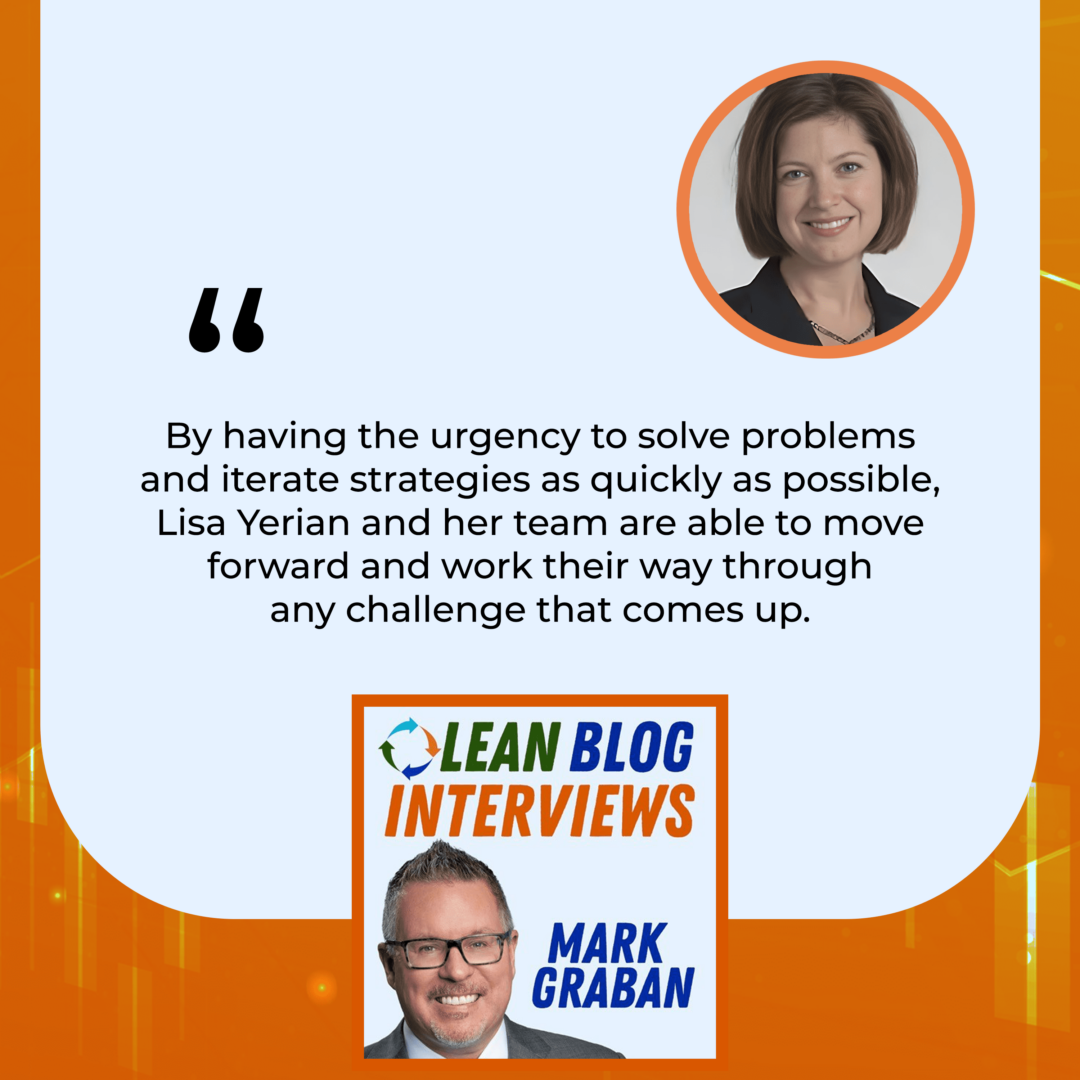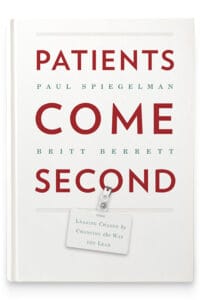My guest for Episode #449 of the Lean Blog Interviews Podcast is Lisa Yerian, MD.
She joined Cleveland Clinic in anatomic pathology in 2004, and has held several pathology and enterprise leadership positions. After 10 years serving as Medical Director of Continuous Improvement, Dr. Yerian was named Cleveland Clinic's first Chief Improvement Officer of Continuous Improvement in December 2019.
She's going to be one of the keynote speakers at the 2022 AME Conference, being held in Dallas — Oct 17 to 20. I'll be there and I hope you will be too.
Lisa was previously a guest here in Episode 282 back in 2017. Also joining that for that episode was our friend and her colleague, Nate Hurle.
Today, We Discuss Topics And Questions Including:
- Remembering Nate Hurle (my blog post)
- My last podcast with him (episode 404), Nate talked about how the CCIM and your continuous improvement work was helping with Covid testing, treatment, and vaccination… new processes.
- As you shared recently at the Catalysis Lean Healthcare Transformation Summit, how did your Lean management system get you through Covid?
- Daily management system
- Tiered daily huddles
- Problem solving systems
- “Covid put that system to the test”
- Adaptations were required — learned how to make changes to the standard work in hours, not weeks
- Urgency – had to work past the old expectation that it takes 3 months to solve problems
- The Cleveland Clinic journey
- 2006: project-based work and some basic tools
- 2012: deliberately focused on building culture
- Started a “culture of improvement” A3
- Defined current state, future state — and the gap
- Challenge: perception that we're already doing well enough
- Little Red Book of Selling (a book Nate loved)
- Culture of excellence – “Not getting better fast enough”
- A3 problem solving
- “Having a piece of paper is a way to de-escalate…”
- Building on a culture of patients first
- Lisa's appearance with me on the Habitual Excellence podcast
- Good enough, world class, vs. aiming for zero harm?
The podcast is sponsored by Stiles Associates, now in their 30th year of business. They are the go-to Lean recruiting firm serving the manufacturing, private equity, and healthcare industries. Learn more.
This podcast is part of the #LeanCommunicators network.
Watch the episode here
Listen to the podcast here
Lisa Yerian, MD On The Cleveland Clinic's Improvement Journey And How Lean Got Them Through COVID

It's episode 449 for June 29th, 2022. Our guest in this episode is Dr. Lisa Yerian from the Cleveland Clinic. She's going to be talking about their journey with continuous improvement, problem-solving, and lean management systems. It's a journey that started in its earliest form for them way back in 2006. We're going to be talking a lot about the last two years and how Lean got them through COVID, or how the methods and approaches they've been developing and practicing made difficult and unprecedented times go more smoothly than they would've gone otherwise. As always, it was great talking to Lisa and hearing her thoughts and reflections. As always, I want to thank you for reading. Here's this day's episode.
—
My returning guest in this episode is Dr. Lisa Yerian. She joined the Cleveland Clinic in the Anatomic Pathology Department back in 2004. She's held several pathology and enterprise leadership positions and after ten years of serving as a Medical Director of Continuous Improvement, Lisa was named Cleveland Clinic's first Chief Improvement Officer of Continuous Improvement in December 2019.
Lisa's going to be one of the keynote speakers at the 2022 AME Conference that's being held in Dallas from October 17th to 20th. You can learn more at www.AME.org. As I mentioned, Lisa was previously a guest here on episode 282 a few years ago. Also, joining us for that episode was our friend and her colleague and friend Nate Hurle. Lisa, as I welcome you back to the show, thank you for being here. I know we wanted to start by taking some time to remember Nate.
Thanks so much, Mark, for having me. I appreciated spending some time with you at the Catalysis Conference. It's good to see you and it's nice to have time to remember Nate, and it's a little sad to be here together with Nate. Nate's the person who introduced me to you, Mark. You might remember, he very deliberately sought a conference that you would be at and attended for the sole purpose of meeting, befriending, and convincing you to come and visit us.
That was a hard sell. That was a nice offer and an opportunity that he and you provided.
We certainly enjoyed the partnership. I know he was a big fan of you. One of the things that I can appreciate and miss about Nate is that he always made things fun. When we did an episode with you in the past, he had a nice combination of pushing our thinking forward with great questions and reflections and doing it in a way that was not only challenging but fun to be challenged in that way. We miss him a lot.
I appreciated Nate and admired what he and you two were doing together. Those opportunities to visit, to do the show, and to have some fun going out to a baseball game together. There are a lot of memories, and it's been about a year since his passing. We do miss him and I thankfully have the recordings including the episode that the three of us did together.
Also, the episode that Nate and I did was episode 404. I'm going to make a bad computer joke here. It's ironic. 404 is the error code for Not Found, and I'm glad the recording is still there. We miss Nate, even though he is not found with us every day, he's remembered. I'm sure you and your colleagues think about him a lot.
We had a team picnic, and it's one of his favorite events of the year. It was nice to be together as a team and to have a community in which to mourn and miss him. It's not the same without him, for sure.
Nate was generous in his sharing of what you all were doing. In that last episode, we talked about COVID times, ramping up new processes or radically different new versions of processes around mass testing, and standing up new treatment options and the mass vaccination era. One thing I remember is Nate didn't take credit for that. He was very gracious and generous in talking about what the team and the organization had done. There was a lot of great work. I know he played a big role in leading and challenging and bringing people along.
I agree with you. Nate didn't take credit because he could see how many other people were involved in doing that work. There's very little that we do, if anything, on our own. We're always working with doctors, nurses, techs, and other caregivers in the organization but what Nate brought that was so unique and powerful was the method. It was a very clear, focused method on what our next problem to solve is.
Early on in the pandemic, everybody in healthcare maybe was facing essentially the same set of problems. How do we keep our patients safe? How do we keep our caregivers safe? How do we prepare for this massive unknown? We had different versions of those problems, but in some ways, we were all dealing with the same problems.
That initial reaction is common. Even at the Cleveland Clinic or at places that have been doing continuous improvement for a while, I suspect an initial reaction of firefighting and overwhelm if you don't have a method. When it came to the testing center, which was that first big effort as soon as COVID arrived in Cleveland, what he brought was a sense of order and how we solve this big complex problem by breaking it down into very clear next problems to solve and taking a very rapid PDCA approach to it.
Having a clear method that was already recognized and known to be effective provided this tremendous sense of reassurance to the team that enabled them to calm down and focus on the problem that was in front of them. There were many other people who stood in a very cold parking garage in March in Cleveland. It was scary and patients were scared. It was hard, but that core focuses on problem-solving and having a known effective method gave everybody confidence and hope.
Also, when facing a scary and hard challenge that's complicated and can be overwhelming, that clarity, that confidence, and hope makes a world of difference. He continued to do that throughout the pandemic across our Cleveland Clinic community and many places in healthcare. That is something that folks will remember and appreciate Nate for a long time.
When facing a scary, complicated, and overwhelming challenge, having the clarity, confidence, and hope makes a world of difference. Share on XThat approach that you describe and this methodology for solving problems are powerful. There are many that look for best practices. They look to journal articles, not to discount any of that at the right place and the right time but when you're doing unprecedented things in unprecedented times, you have to develop something. There had been years of practice with that model. As a recap for the readers, when did that journey begin? I want to come back and talk with you more about the pandemic times, but when would you say that journey started?
We first created what would be recognized as a continuous improvement team in 2006. That was before I was involved. Nate was recruited in 2007. In 2009, I started to work with the team. At that point, we were doing a lot of project-based work. We would take on big projects and some tools. There were some basic tools we were offering. It was in late 2012 that we started to deliberately focus on building a culture. I've spoken before about the charge to shift from, “We've been doing this continuous improvement stuff for years. When are we going to fundamentally change the culture?”
In late 2012, we started our culture of improvement, A3. We articulated the current state, and the desired state, and analyzed what was between here and there, what was getting in the way, and what was going to help us. It was through that A3 that we developed our initial model areas. It was that deliberate model area work and I want to clarify. Many people do model areas like the model nursing unit or the model laboratory testing process or something.
Our model was about modeling the culture. How could we develop a way to create the ideal culture? For us, that was a culture we defined as every caregiver capable, empowered, and expected to make improvements every day. When we started to work on that, we met the first team, and the first thing they told us about was problems. We found that pretty consistently. People don't come to us saying, “We want a daily management system or a visual management system.” They face problems in their work so we started with problem solving.
That was in 2013 that we were working with that team and evolved from the initial problem-solving, which was A3-based to how we create a system that enables this team to continue to identify and solve problems in an ongoing way. We developed the problem-solving system, which became the first system in our model. As that team continued to work, and then other teams began to come to see and engage, we then identified new needs or additional needs, and then centered on over time, the four key systems of our model.
However, it took us years before we spread that broadly. In 2013, was when the nursing leader, the Executive Chief Nursing Officer at the time, Dr. Kelly Hancock, came to see it and asked us to work in nursing. The inpatient nursing unit was one of the first sites that you visited when you first visited us. It was years before we got broad involvement, capability, traction, and engagement in problem-solving as a methodology.
I remember the visit and I believe Kelly was there to continue to see what people were working on and to share the progress and the credit for all of that. Let's do some time hopping though. Let's jump ahead then or we'll maybe jump back in time. This was maybe then early 2020, 7 or 8 years into that part of the journey around focusing on culture and problem-solving.
You addressed this on stage at the Catalysis Summit but I want to ask you for this audience. What's your summary looking back at how the Cleveland Clinic improvement model, continuous improvement, problem-solving, Lean management system, and all of these different labels we could put on this? How was that helpful from your perspective during the pandemic times?
I would say that the two key systems that we found most helpful were our daily management system and our tiered daily huddles. In 2018, we developed an enterprise-wide tiered daily huddle system to enable us to identify and solve problems rapidly, support our caregivers, and foster this culture of identifying and solving problems or opportunities across the enterprise.
That was a dramatic shift for our organization. In reflection, I never thought about this at the time. As a physician, when you are learning about continuous improvement and Lean, you hear all these things and you're like, “I hear this. Problems are opportunities. We should embrace problems and ask people to elevate them,” but there's this very practical translation that seemed to never become apparent to me. I can't say it's not out there, but it never became clear to me. Saying that doesn't enable people to do it, and certainly doesn't get them to do it.
There's this very practical component for elevating problems that is, “When do you want me to do that? Where do you want me to do that? How do you want me to do that? What's going to happen when I do?” None of that gets completed when we just say, “You should embrace problems as opportunities, and you should encourage your team to bring forth problems.” It's something that folks could nod their head to, but never actually do. It's hard like, “Be nice or be good.” It's vague.
The tiered daily huddle system gave every manager and leader a very concrete time, place, opportunity, agenda, and method where they could do that. They would say, “What problems happened in our area?” They might be a potentially serious safety event. It might be a patient fall, a caregiver experience issue, or a patient experience issue. People needed to bring those forth. There you were as a manager asking for that, and then people bring it to you. There's your ideal opportunity to embrace it and say, “Thank you for bringing that forward. Let's talk about it,” or whatever your next step is, what your method is, or what do we understand about the root cause?

You can move into the Coaching Kata, but it provided that anchor. Because it's scheduled, it gave you time to practice being that type of problem-embracing leader on a regular basis. That foundation was in place. COVID enabled us to put that system to the test. Suddenly, we had a whole lot of new problems that we had never faced before and never would've been able to anticipate if we didn't have the system in place that enabled us to, in a tiered cascaded fashion, every day at the same time and the same place identify what are the existing problems. Also, what are the new problems that our team members are facing because of COVID, and then help support each other and our teams in solving those problems through the tiered daily huddle system?
We took that system. We had some standard work around how we changed the agenda. We accelerated and modified that standard work because before, it would take us weeks to make a change. We made these changes within hours to say, “Now, we need to know how many patients we have with COVID. How many are under investigation?” At that point, we were treating them essentially as though they did. How many caregivers are out with COVID and how do we aggregate that information across the entire organization?
We were able to pivot that very quickly, and people were suddenly leaning into huddles much more heavily because now it was a have-to-know. There's so much urgency around COVID. Factions are at stake. Lives were believed to be at stake, and in some cases, worse. They are clinging to the system that we had in celebration of something that in the prior couple of years had been built, but hadn't had that urgency around it.
I'd say one is the tiered huddle system. We also built problem-solving systems. Again, they were typically systems around which teams would huddle once a week or every couple of weeks. They would huddle at their Kaizen board and talk about what were the problems in front of us. Also, A3 in some cases be done through a collaborative A3 problem-solving program where we would spend a lot of time teaching people how to do a root cause analysis or how to analyze their data.
That was basically a three-month program. We had unwittingly created this expectation that it takes three months to solve a problem. Now, we had this urgency, which enabled us to pivot to say, “No. We don't need three months. In fact, there's no way we can take three months to sit up the testing site.” We did it in 4 or 5 days but you can use that methodology. What was good that we had in place was an acceptance of the methodology.
Folks, for the most part, believed in the methodology as an effective way to problem solve. They didn't see how agile it could be and how rapidly we could apply it. COVID gave us an opportunity to say, “With these very acute problems, we can use it quickly.” Those would be I would say the two main and most important ones. Also, then the idea of PDCA as part of the problem-solving methodology is we're not going to have time to perfect anything, or to your point, wait for somebody else to develop a best practice or go search the literature.
We only have to try something and then when we see how it works, make it better. Throughout all the problem-solving activities, we were trying to make our performance visible, leverage standard work, and do PDCA so that we could continue to improve the way that we were doing it. Having found those foundational pieces in place meant that we didn't have to spend a lot of time talking about how we are going to share information, identify problems, and solve these problems. It was our core method, and it was how we adapt these to solve these types of problems at this pace, which we mostly hadn't had to in the past.
I hear you talking about two key things, importance and urgency. The urgency of having to solve problems quickly, having to iterate quickly, having to move forward, even if we think it's not perfect, but we have to do something and we can iterate our way through anything that comes up. It's urgency. However, on importance, one thing that you said in your discussion with John Toussaint and John Shook at the summit, I remember you saying, correct me if I'm wrong or elaborate on this, something the effect of, “If you're giving people a countermeasure that's not a countermeasure to a problem that they care about, the adoption of that countermeasure might not be as enthusiastic.”
To your point, nobody speaks up and says, “We want a Lean management system.” They might also not ask for a countermeasure like daily tiered huddles but it sounds like the importance of those huddles during COVID times would pique people's attention. If they didn't already believe it, I'm sure there are people who did believe it through their existing practice. They say, “These huddles are now critically important. We're all in on participating and making the most of it.” Is that fair to say?
Yeah. I appreciate that you brought forth my comment. I've seen that over and over again. Some of us who are in the business of change wander around asking, “Why isn't anybody interested in my fantastic countermeasure?” Your countermeasure might be fantastic, but in some cases, people need to feel like they have a problem.
Nate used to talk a lot about this book. It was called The Little Red Book of Selling that he loved and I have a Xerox copy because he Xeroxed it because he wanted me to read it over and over again. It's about like understanding what the customer's need or problem is. Sometimes when people are interested in our countermeasure, they think about, in some way, pretty much everything that we offer or sell is a countermeasure to something.

We default on trying to tell people how wonderful the countermeasure is. If I'm not experiencing a problem, then I don't care. All of our countermeasures, even if you have your internal team, cost your time, your energy, and your focus. Those are finite resources, particularly, in a healthcare environment and now.
Even if you're going to help as a CI person, that leader, manager, or caregiver has got to invest something. You're much better off understanding the problems they are facing and then when you can attach that countermeasure to a problem they've experienced, that's when it becomes something that's attractive to them.
It's The Little Red Book of Selling: 12.5 Principles of Sales Greatness. That's a good subtitle. It makes me curious, “Why is it 12.5?”
You should read it. Nate would be thrilled.
Gaining acceptance to change is a complex process to help people work through. Going back to what you said about going back to 2012, I could hear the A3 thinking. You described this A3 as a culture of improvement. I appreciate that you started with a description of the current state and then a future state. That gap helps then influence what we work on or how we break down that problem and start making progress.
I hear people all the time, “We'll talk about a future state,” or they'll have a vague goal of, “We need to transform the culture.” I'm like, “From what to what?” They might articulate the future. My question for you, Lisa, is was it painful at all to describe the current state, good, bad, or otherwise to try to get a consensus around what is the current state?
Yes. It was difficult. There were multiple challenges. One of our challenges was a sense that we were doing pretty well. You could arguably point to evidence that the Cleveland Clinic is doing well enough. Why should we build this culture? What does a culture of improvement even mean when you already have a culture of excellence? I don't think many folks would say we have a culture of complacency at the Cleveland Clinic.
We have a culture of excellence. What do I mean by a culture of improvement? How's it different? There are also competing interests in what is the method or the how or what we need to create a culture of improvement. It took me a long time to think through this, but I think it's about the method. If I think about a culture of excellence, I reflect on my own tendencies. I was always somebody who was trying to achieve and make things better. Make myself better, perform better, or whatever but my method was to try hard as an independent agent or as an individual.
I might call on others for help, but oftentimes my play is to try harder. It happens a lot in healthcare. If I'm a nurse or a tech, rather than fix the system to make it work better for everyone all the time, I've figured out my own ways. If you talk to people, a lot of them say, “This is the way I do it because it works a little better. This is the way I do it because it works a little better or I always do this or whatever.” People are exhausted.
What I hear is, “This works for me.” Is that the key criterion now?
If you have nothing else, then what works for you? If you have no other options, if you have no method to figure out what works best or most consistently for everyone, then that's what it ends up being. It's a culture of improvement that's based on developing a method that's going to be better consistently or is going to consistently deliver better outcomes. There was also a component of, “We're not getting better fast enough and we're not going to be able to improve as quickly as we need to.”
If you have no method to figure out what works best or most consistently for everyone, that's what it ends up being. You need a culture of improvement to consistently deliver better outcomes. Share on XEven though we have a strong brand reputation, we perform well in some things. We certainly have very real opportunities in some of our safety, quality, and patient experience metrics. It's highlighting some of those gaps, which some folks are not thrilled or comfortable with somebody running around highlighting with her A3.
There were also folks who had been working to foster continuous improvement or quality improvement in some way in the organization since 2006. Me showing up and saying, “I'm holding a pencil around how do we do this,” could make other folks feel threatened that the way they were doing it or working to solve that problem or close that gap wasn't enough or wasn't good enough.
Here I am trying to highlight a problem that at the current state, you got to talk about the problems that sometimes people felt sensitive about or people didn't feel good about. However, I found that the A3 and I got the advice to do the A3 from a friend Mark Reich, who was working at the Lean Enterprise Institute. He used to work at Toyota. He's well-versed in Lean. I didn't come up with this on my own. Having a good friend coach is incredibly important.
However, having a piece of paper is a way to deescalate pretty quickly and easily. It's not I'm showing up in a boardroom or a high-stakes space with a fancy PowerPoint that feels done and polished. It's sitting down with Lisa with this piece of paper that's very messy, and watching her write, take notes, and revise the thinking or the story as you're talking with her. I found out this trick and I've talked about this before too, that if I'm talking with you, I would pick up a different color pen.
I know the classical lean thing is to use a pencil but if I used a pen in a different color, it would help you see where your thinking had filled in. You could see however much green or blue was getting added to the piece of paper, and how much you were influencing what the story or the narrative was for this change. It was a good enough thing to get us started. It most certainly could have been better, but that's probably the advice I give most folks.
I had dinner with an organization that wanted to tell me much as you described like, “We're going to start this transformation.” They had logos, boards, posters, and all these countermeasures and solutions that they had developed, and they were very excited about it. I listened, and as they were wrapping it up, they want to know what I thought of it.
I said, “What is the purpose of this transformation that you're planning?” They paused and looked at each other. They spend more time developing countermeasures than understanding what the purpose is. What COVID did was give us this very clear urgency and purpose. At that point, we didn't have to spend any time convincing people that we needed to do it. Again, what's your method? Everybody's going to be solving problems.
COVID taught teams to embrace urgency and purpose. Everyone learned not to waste time to solve problems. Share on XAre we going to use a tried and proven method where not only do we know that it's effective or more effective than trying hard or more effective than whatever other method we would use? We all have a common method. As we move in and out of project teams, which we were doing a lot, we all had a common set of tools, a common language, a common approach and we could rely on some core principles. That was powerful.
When you mentioned purpose, that's getting to the upper left corner or the left-hand side of the A3 before we even dive into describing the reality, whether that's processes, facts, or mindsets that exist. It's probably easier to get our heads wrapped around a physical process with the physical flow. The flow of specimens through a pathology process can be observed more directly than these elements of culture, principles, and mindsets.
That's a good reminder to even start there. Why are we talking about this? Why is it important to gain clarity around that? Back to your A3, I'm not a stickler on doing it in pencil or electronically or whatever, because it's the thinking, but we'll try to find you a set of colored pencils that are also erasable. There is also erasable ink we could use. I love those little clicky four-colored pens. There has got to be a version that's erasable.
I would expect so. I'm not so worried about it. I'm not a stickler for pencils and I'm also, as you heard at Catalysis, not a stickler for a literal translation of the word Gemba.
One other conversation that Lisa and I had was back in episode seven of a different podcast series, the Habitual Excellence podcast series through Value Capture. One thing that's very noticeable, not because it says things on the walls when I've had the chance to visit Cleveland Clinic sites, is there does seem to be a strong culture of patients first, which seems like one of those pieces of existing culture or state culture that you would want to be strengthening through any of this work that you're doing to improve the culture. Can you share a little bit more about how you stay grounded maybe in the improvement work that you're doing to make sure that it remains to that patients first principle?
If we think back to the A3, one of the suggestions that Mark Reich had made was to think about the analysis in terms of what's helping, or what's supporting or enabling the culture you desire or your target condition, and what's working against you. Very quickly, that patients first culture became an enabling element.
When I heard about and visited other organizations who were pursuing Lean, it felt like that emphasis on the customer was a little bit harder to create and capture in their improvement work. For us, that patients first emphasis was already in place, which was great. I didn't have to convince people to improve. For example, I had visited places or been asked by others, “How do we get people to engage in improvement work or to want to improve?” I was like, “What do you mean?”
They're like, “How do you get doctors to participate?” I was like, “We just asked them.” They look at me like I have three heads or I'm totally lying and I'm not because it depends on what I'm asking them. If I say, “Take hours and hours out of your day to do something that doesn't feel value-added,” because I'm calling it lean or a Kaizen event, I would not be able to get people to be involved.
However, if I say, “We're trying to make something better for patients, can we get your input? Can we get this? What's the support?” people will have no problem engaging. The limitation that we face in patients first is that we're so focused on identifying the needs of the patient. We're very focused on or we try to be focused on empathy but again, it enables trying harder. It enables heroism, which is not a reliable structured improvement methodology that's going to enable us to consistently deliver better for the patient.
What we had to do and continue to work to do is make sure that when we believe and want to be doing what's best for patients, we have some data and evidence of what that is. Sometimes we get caught up in imagining or believing what we think is best for patients. Sometimes, we need to challenge that to say, “Have we asked them, ‘What's your evidence? What's your data?'”
We also have, in some cases, developed some countermeasures. One of them is a panel of patients that we ask for input and opinions to help us develop processes, which is great. However, there's a tremendous amount of bias that can be introduced by a panel of people who have the time, interest, and investment to be serving on this type of panel for the Cleveland Clinic that may not be representative of the millions of people that we see every day, every year. Pushing on even that to say, “Is that the best way to get diverse, comprehensive, and quality information about what our patients want and need?”
There's another trap that I've seen of that patient role being filled by somebody who's also a staff member. I was working for a children's hospital probably a decade ago and we talked about getting parent representation in this work we were doing. They said, “So and so over here, their child had been a patient here at the hospital.” We had a lot of discussions around, “You're a parent, but you also know a little too much about how things work here that's different from somebody that's a purely external fresh eyes perspective perhaps.”
Also, sometimes if you work there, you have a different experience because people recognize you. My father was involved in a terrible accident. A tree branch fell and broke his neck in three places. It hit him in the head. He lives in the country and they transferred him here. I went into the ER to meet the ambulance wearing my badge. I know that my experience was for better or for worse, different than what somebody else experiences. The fact that I could even go in is probably dramatically different from another's experience. Also, it may not be the best way to do it.
Here's what I would propose. I'm curious to hear your reactions to it. The patients first doesn't mean patients only. With the patients first perspective, you can also care deeply about the staff of making sure they're not overburdened, that we're not relying on hero culture or workarounds, and that we can focus on trying to prevent burnout or help people recover from burnout if it's happened. I was curious if you could share your thoughts on also addressing staff needs even in normal times.
I'm a big believer in respect for people, and that's the patients and the caregivers who have real needs. Our vision that our CEO brought in and I love is that we are the best place to receive care anywhere and the best place to work in healthcare. Creating processes or implementing countermeasures that are fantastic for patients but are bad for caregivers or too overly burdensome or do not support caregivers are unsustainable, first of all, because caregivers are never going to continue to practice them or use those processes. You'll be back to workarounds and non-standard processes or ways to deliver things.

However, taking care of your caregivers is the way to take care of patients, especially in the economy now where staffing and hiring are difficult. We and others are struggling to hire enough people, keep people, or retain people. Having an environment where you're treated with respect is incredibly important. Also, having processes that are not perceived to be, or prioritizing the experience of patients to the detriment of caregivers is untenable. It's not sustainable.
One of the major benefits that I see of the continuous improvement work is the ability to enable caregivers to improve care. That is the most energizing, transformative, and engaging activity I've ever seen. Part of it is the ability to make things better, to know you make things better, and to know how you made things better, which engenders a sense of agency. Part of it is having evidence of the work that you're doing. In some cases, before you've even improved anything, it can be very rewarding and exciting.
I've seen this time and time again. I shared an example at the Catalysis meeting. One of my assignments now is access. I now lead a large team supporting access to healthcare, scheduling, and things like that. One of the teams does transplant scheduling. I got this emailed report of how many patients we had transplanted so far this year, and I offered it to the team. They were ecstatic because they had been scheduling and scheduling but they had no idea how many of those patients went on to receive a transplant which is a lifesaving and life-changing experience.
Do you think about how fun would this show be for you, Mark, if nobody ever posted anything in the chat? You don't know how many people viewed it. Nobody ever came up to you and talked to you about it or ask you about it. It would be work. It wouldn't be fun at all. It wouldn't be rewarding. It wouldn't be engaging. It's such a simple idea that you give people evidence of their work as a way to engage and motivate them but yet, in so many ways and places, even those basic things we don't do or haven't done.
I don't know if that's a continuous improvement principle or a Lean principle. We talk about visual management, but I get the impression that we talk more because we want to understand performance and identify problems. We want to use it strategically to solve problems. It's at least as valuable, if not more so to engage people in the work that they're doing to provide meaning and to provide a sense of impact.
By understanding performance and identifying problems within the team, leaders can engage people to provide meaning and a sense of impact. Share on XThat's a powerful example you shared of helping remind people of purpose and to close the loop about the impact of their work. I've said this for a long time about the show. There is some inherent enjoyment in this conversation with you. These are conversations that I enjoy in and of themselves, and the fact that I get to record and share with others is icing on the cake.
I enjoy them as well.
The only enjoyment does not come from looking at the show statistics. I'm thankful for everybody who takes the time to read and learn. It is nice when somebody does come up, though. I appreciate it when someone comes up and says hi at a place like the Catalysis Summit or AME conference like, “I read your blog. Thanks for doing those.” That helps. I do appreciate that.
I want to share a thought when you talk about the best place to receive care and the best place to work in healthcare. There are kindred spirit thoughts I've heard articulated by the people at UMass Memorial Health where the way they articulate it is the best place to give care and the best place to receive care. There are those two pieces together.
I don't know if it matters which order you put those in, but it's a yin and yang that go hand in hand. I had a guest years ago who wrote a book with a fairly provocative title, or intentionally provocative. It's Patients Come Second, and that's the camp that says, “If you take care of the staff, they can take care of the patients. I don't know if 1st or 2nd matters, but both. It's not either/or.

You clearly need both. Probably in any business or any organization, you need an emphasis on both. Can you navigate supporting both and what's the best way to navigate supporting both? Everybody's going to face problems. Everybody's going to be solving problems. What's the method that you're going to use to make sure that you can stay true to both?
Maybe a final topic here, Lisa. Touching on something that your colleague Melissa Vandergriff shared at the Catalysis Summit of having a method for creating alignment up and down side to side in the organization. It's not enough just to have this goal. We need better alignment. What does that mean? Melissa shared about an approach which is OKRs, which people probably more associate with Silicon Valley or startups.
John Doerr is a venture capitalist. His book, Measure What Matters, talks about this OKR methodology, Objectives and Key Results. I was wondering if you could share either in that context or additionally, what are some of the things that the Cleveland Clinic's trying to do to build greater alignment.
We've been learning and applying the OKRs pretty broadly across the organization. We started with the CEO creating and sharing a set of objectives and key results that spanned our four care priorities, caring for patients, caring for caregivers, caring for the community, caring for the organization, and also, research and education. After he did that, we started to work with them on the executive team. It's his direct reports, and now we're using them deeper into the organization, in our institutes, our hospitals, and our divisions. I use them with my team, for instance.
I've been there for many years. I'm not sure that we've ever had a clearly articulated strategic plan with a real deployment focus. There were bright spots. There were places where individual leaders valued it, emphasized it, and build it but as an enterprise, there was no clear method that provided clarity on what people could attach to.
What our CEO, Dr. Tom Mihaljevic did with OKRs is he provided his set of goals and priorities for the organization. The OKRs became a method that people could use to look at their leader's OKRs, look right, look left, and then develop what are those objectives, and then what are the key results. There are several things I like about them. One is, it's not just activity or key results. It's, “What's the objective? Why do these matter? What is it that I'm trying to accomplish here?”
If you use a template or tool, whatever your format is, it provides a common construct that we can use to bring our team together, look at them on a cadence in a repeated way, and look at each other. We have our Chief of Staff, Dr. Beri Ridgeway. All of the clinical institute chairs report to her. She asked them to use this common format and method so that she has maybe twenty direct reports. She's not looking at twenty different sets of goals of varying length and format. We're all going to do it the same way so that we can be efficient in understanding what everyone's working on and looking across to see how it all connects.
It has provided a lot of improvement in our organization in terms of alignment. It's also fairly flexible. I've seen and heard about organizations where they try to be very structured with straight-line goal alignment, one-to-one. I don't think that would work well for us. Our organization is very innovative. People would feel constrained by a very structured one-to-one. You have to work on exactly a subset of whatever your boss is doing.
I don't think people have the patience to go through all of the math or all of the detailed work to make sure all those align. One of the things John Doerr talks about in the book is misalignment stands out. It's pretty easy for me to look at a short set of your OKRs and a short set of my OKRs and say, “Are Mark and Lisa working towards the same thing or not? Let's talk about that,” without us having to very deliberately write all that out or articulate all of that.
It gives us some flexibility. We have derived value from it. It's the kind of thing where people don't recognize they have a problem and say, “I need an organizational alignment system but when they start to see it, experience it, huddle around it, and practice using it, they appreciate the clarity and the focus that it brings their team.
It seemed to me to be very similar conceptually to strategy deployment in terms of what people are trying to accomplish through that. One example comes to mind, for me, that sounds like what you were talking about in terms of having the alignment and not being too rigid. There was an organization I visited where one of their high-level goals or objectives was reducing patient harm or eliminating patient harm.
One of the measures they were using was patient falls. While they were cascading that measure to every part of the organization and there are some parts of the organization where patient falls are not relevant. I remember the one example where they learned this was an iteration and an opportunity for learning.
The labor and delivery department pushed back and said, “We don't think our key patient safety measure should be falls. We should choose something else that rolls up and contributes to a measure of serious harm incident.” I appreciated them sharing that example. Maybe the first pass is very strict, and then there's feedback, or if it's too loose, to your point, you notice it and you can iterate and bring it to closer alignment.
That takes practice. We talk about catchball a lot. It takes practice to learn how to do that. We have leaders who don't want to provide any or want to provide very little constraint or guidance to their team. We have other leaders who are much more heavy-handed at that. However, you're right. The falls are a great example. Also, central line infections, sepsis mortality, and things like that.
For some org parts of the organization, they have very few central lines and sepsis isn't an issue for their patients. You don't want to have them have a goal that feels meaningless to them because they don't have the ability to drive it. Getting back to our sense of engagement and purpose, you want everybody focused on what matters most in those areas.
You don't want your team to have meaningless goals. Get back to your sense of engagement and purpose. Share on XIt may not be easy to draw a straight line through the entire organization to the enterprise OKRs for every single one of those things but that's the leader's job to say, “If I'm managing obstetrics and the emergency department, I need to make sure they're both focused on what matters most in their arenas and what's going to be most impactful for their patients and their caregivers. Also, how do I pull those together to make sense of it at my level to align with what my leader does?”
Lisa, thank you for sharing some of the progress and continued iteration and evolution of your approach, you and everybody there at the Cleveland Clinic. Again, as a final reminder here, the AME Annual Conference year 2022 October 17th to 20th in Dallas. You can learn more at AME.org. I have a final question for you, Lisa. You had an opportunity at the Catalysis Summit to speak to the healthcare audience.
A friend of mine who works in construction or it's related to healthcare construction so maybe he is a healthcare person. We'll call it 98% healthcare people. At the AME conference in past years, we'll call it 20% to 30% healthcare people. What's the opportunity given a broader audience of people from all sorts of different industries?
I probably need to spend some time with the customer or with people in other industries. Some of the experiences that I've had talking to folks in other industries is curiosity about Lean in healthcare. We may not all work in healthcare, but we're all users of healthcare. Although it's a little bit dangerous, if I were not in healthcare, if I were the customer, what I'd be interested in is, “When is it going to get better?”
“When can we expect that what we've gotten in other industries is a higher quality outcome at a lower cost may be, but the higher quality outcome for sure? When are we going to see healthcare in the airline industry and automotive industry production become much more reliable and safer? When are we going to see these gains in healthcare and how are we going to get there? What do we need to do to get there?” That's part of what I'm going to attempt to tackle. Do you have any suggestions?

I agree with you. People have a personal interest in the healthcare system, whether they're a patient or family member or have been or they know they will be at some point. There is deep curiosity and I think there are opportunities to help connect the dots about culture, leadership, and methodology for improvement. Not only hopes and dreams of improvement, but methodology.
There's a lot to learn back across other industries. My wife, who you'll have a chance to meet at AME, is going to be part of a panel there. She's learned a lot from an opportunity. John Toussaint invited her to come to visit ThedaCare back in the day. She learned a lot, particularly about strategy deployment because that's a management process. It's a culture, and she was able to bring that back into the manufacturing space. I know there's a lot of opportunity to learn in all directions.
Hopefully, share some good stories, inspire some folks, and share some good learning. I look forward to seeing you and meeting Amy there.
Again, our guest in this episode is Dr. Lisa Yerian. Come join us at AME. You can not only hear her speak but have a chance to ask questions of your own and chat about the healthcare system and lessons that you could bring back either to your health system or your own organization regardless of where you work. Lisa, this has been a lot of fun. Let's do this again more frequently than every five years maybe. How about that?
We should do the turnabout.
We could do that. Lisa wants to play guest host and ask me questions.
Your audience would love to hear Mark's point of view.
Hopefully, I'll have answers worthy of the questions, but let's do that.
That would be fun. I would love to talk again.
I look forward to that. Thanks for being here on the show again, Lisa.
Thank you, Mark. Enjoy your day.
Important Links
- Dr. Lisa Yerian
- www.AME.org
- Episode 282 – Past Episode
- Remembering and Mourning Nate Hurle
- Catalysis Conference
- Episode 404 – Past Episode
- The Little Red Book of Selling
- Episode seven – Lisa on the Habitual Excellence podcast
- Patients Come Second
- Measure What Matters
- Keynote Speakers at the 2022 AME Conference
Please scroll down (or click) to post a comment. Connect with me on LinkedIn.
Let’s work together to build a culture of continuous improvement and psychological safety. If you're a leader looking to create lasting change—not just projects—I help organizations:
- Engage people at all levels in sustainable improvement
- Shift from fear of mistakes to learning from them
- Apply Lean thinking in practical, people-centered ways
Interested in coaching or a keynote talk? Let’s start a conversation.







![When Was the Last Time a Leader Around You Admitted They Were Wrong? [Poll]](https://www.leanblog.org/wp-content/uploads/2025/07/Lean-Blog-Post-Cover-Image-2025-07-01T212509.843-238x178.jpg)


![When Was the Last Time a Leader Around You Admitted They Were Wrong? [Poll]](https://www.leanblog.org/wp-content/uploads/2025/07/Lean-Blog-Post-Cover-Image-2025-07-01T212509.843-100x75.jpg)
